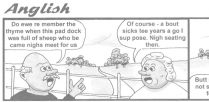A suffix is a letter or group of letters added to the end of a word that forms a derivative of the original and gives extra or a different meaning. It can’t be complete without some sort of root and cannot stand alone in a sentence.
Common Suffix Examples in English
Many suffixes, as well as prefixes, have their origins in other languages, such as Latin and Greek. Each has a definite meaning, though time and use may have gradually altered some of the words they are found in to where they no longer quite fit the meaning of all their parts.
 -ty: condition, quality or state; honesty, longevity, security.
-ty: condition, quality or state; honesty, longevity, security.
-ship: state, condition or ability; horsemanship, craftsmanship, citizenship.
-hood: social status or a group of people; childhood, neighbourhood
-able: able to be; workable, livable, considerable
-ly: changes adjective into adverb; slowly, quickly, freely
-ette: something made smaller; palette, diskette, silhouette
-ful: full of; wasteful, graceful, hopeful
-fy: helps us to put the noun into action; purify, glorify
These ones are also called suffixes
Some of the suffixes are in use for too long, and you may not believe that these examples are suffixes:
-s: plural; girl -> girls
-s: third person singular; he talks
-ed: past tense; he talked
-er/-est: comparative; better/the best
-ing: continuous; working
Suffixes Can Have Hyphens
Certain suffixes require a hyphen, such as “-elect” and “-type.”
“The president-elect held a news conference.”
“For a delicious salad, use an iceberg-type lettuce.”
“-Like”: if the root has three or more syllables, if three -Ls would occur in a row or if a proper noun (a name) is used, “-like” is hyphenated.
“That child has Math skills that are computer-like.”
“We moved forward with snail-like speed.”
“Our current president has led a Truman-like term.”








